Salvage HELEN DENERLEY

5 - 31th August 2023
sawblades
113cm x 248cm
 Caliper Moth
Caliper Moth
Salvage
Salvage has come together with the sort of great leaps only an artist with a lifetime sculpting experience can conjure. It is in many ways Helen Denerley’s Everest, a peak, in her output and at a time when most see the fragility in the natural world around us.Many also feel an affinity with the creatures she sculpts and we share the Earth with: the butterflies and pollinators that Denerley forms from discarded bicycle parts, springs and the now jewel-like screwdriver blades, the gentle grazing goats made from ploughshares, a graceful flying red kite magicked from discarded scythe blades and small birds from old spoons. Here is a resurrection rising from things we throw away too quickly.
Denerley tackles spiders too.A giant one,which dares us to walk under it to share its space. For a moment, as we step below its abdomen, our roles are reversed. We are now vulnerable, the ones at the mercy of the natural world. Scale in art always has an unavoidable power. Sculpture as large as a three-meter-high spider, or a 6.5m high infinity column, will always connect us with a larger world,
with the infinite.When we lift our eyes to the top of an infinity column - Denerley’s or Brancusi’s, we are forced to look up towards an endlessly expanding space and the heavens - and to consider our relative size in time and space.
The very small is included in this exhibition too. Denerley’s three bumblebees can be held in the palm of one hand. Honeybees, possibly the best-known pollinator and often brought to orchards in hives to aid our harvests, show how often the smallest can be the most important, but they are at threat from habitat loss, pesticides and disease.We cannot let them suffer. Denerley’s bees have distinct faces and characters and their importance is equal to the greatest creature.
One of Denerley’s recent obsessions is making chess sets.There are sculptural reasons for this.Chess’s thirty-two pieces allow repetition and patterns to form, and this is one of the great joys of sculpture. Bishops, queens, pawns, knights and kings also allow a symbolic imagination to spark. They force us to look at each piece in turn and think about what it is
1
now,what it once was and the move to be made.And when playing,when we touch the work,it becomes more than sculpture on a plinth. Chess is of course the great game. In chess, the move must come and eventually there will be a winner.An earlier chess set had two sides: conservationists and traditional game estates. Current chess sets reuse keys, sparkplugs, meat grinders, old drills and other found items. It is a challenge that rises out of her scrap pile.
The most emotive sculpture in‘Salvage’and the one used on the cover of this publication are the orangutans.We are like them in most ways.They are a little smaller and a bit longer limbed from living mostly in the trees, but looking at an orangutan mother and child is like looking at our better, most caring selves. In Malay the word ‘orang’ translates as person and ‘hutan’ forest.They are people of the forest. We are people from somewhere else. Look closely and you see how much Denerley has felt and conveyed their primate essence into these pieces. The young orangutan, with his small soft ears and wary eyes,sits safely with his mother.He rests on her
strong arm with his long fingers across her knee and his foot on hers. Mother is a protective shell around him: intelligent eyes, hands like ours and with a skeleton recognisable both in its past component life and from ourselves.We see through them, through the negative space which animates the work. This creates a ghost-like quality, making them more precious still.All Denerley’s work has this transient quality, but because they are so like me, they feel even more of a caught moment, a rare glimpse of a vanishing or arriving in the world.They make me look at myself and ask questions. How much like them am I,and the butterflies,goats and spiders too? And how much life lies in a small space? All these creations have risen from a scrap pile on a remote Aberdeenshire hillside. What beauty lies in largest, smallest and most discarded thing.
Tony Davidson Director of Kilmorack Gallery
2
Typewriter Moth
typewriter keys and springs
54cm (h) x 55cm

3
Wee birds
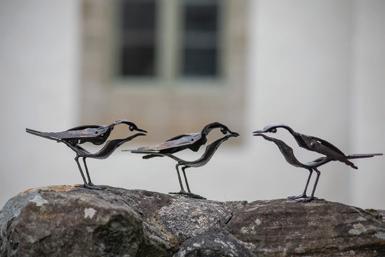
scaffold parts, blades
11cm
Kestrels i & ii
brake shoes, scaffold parts, trowels and garden shears
27cm (h) x 42cm x 11cm
4
27cm (h) x 42cm x


6
Keys Chess set
16cm high king, board 46cm x 46cm

7
Spark plug Chess set
10.5cm high king, board 46cm x 46cm
“There are some pieces of scrap which have been in my pile for many years. They have been too perfect to cut up or manipulate, sculptures in their own right.
The Found Object chess set is a collection of these perfect pieces which now have a greater purpose.“

Found Object chess set 47cm high king, board 120cm x 120cm

Bicyle Butterfly
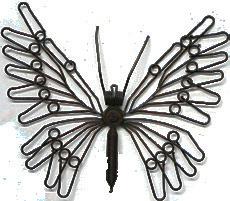

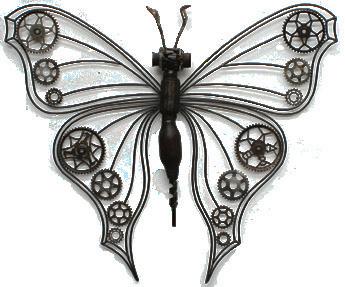
bicycle gears and silencer
120cm (h) x 137cm
Plier Pollinator
pliers and bicycle cogs
107cm (h) x 104cm
Spring Moth
agricultural and motorbike springs
55cm (h) x 65cm
10
Beetle Specimen Box
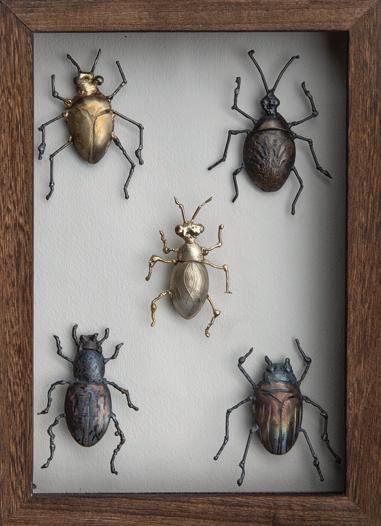
teaspoons
31cm (h) x 22cm x 4.5cm
11
“When I first came across Brancusi’s endless column as a student, I was mesmerised by both its simplicity and its ability to lift our spirits. I’ve long wanted to make one myself and now is the time. I have dragged out those old fire extinguishers which have lain rusting under my elderflower tree for three decades. The column’s secondary components are expansion tanks from oil boilers. Fire and oil.”


12 Infinity Column 6.5 m high
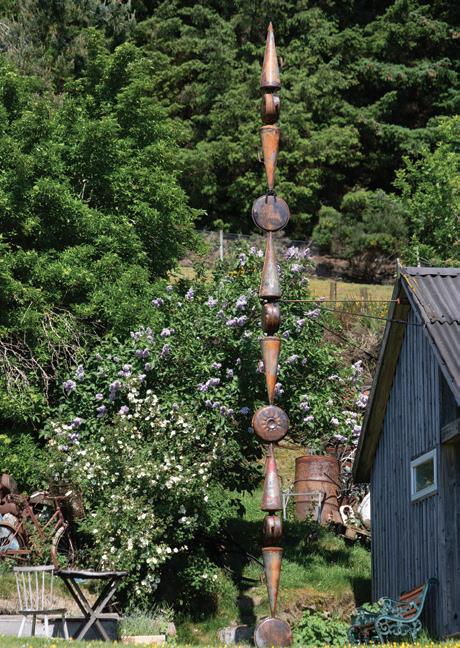
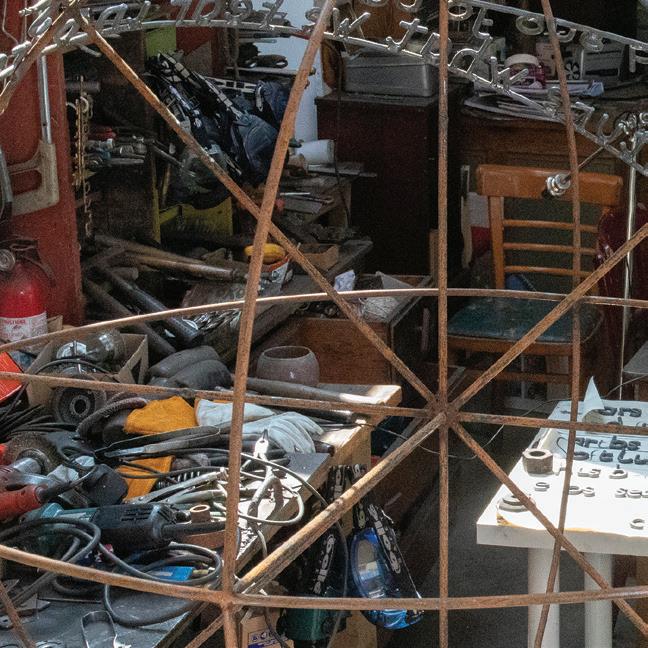

The Haiku Sphere
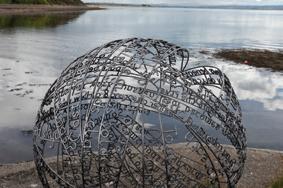
While working in Japan some years ago I visited the Haiku Museum in Tokyo. I have always loved short poetry, where only what is essential is there. It is a very similar process to my own, removing the words or parts of metal until everything which remains is essential. I was unexpectedly moved by the experience of sitting in a small room surrounded by Haiku scrolls, beautiful paintings and calligraphy but in a language I couldn’t read. It seemed like the intensity of the words and paintings collectively created an overwhelming emotional experience which I have never forgotten.
I decided to collect some Haiku poetry and create a sculpture full of words. This led to a unique and wonderful collaboration with nineteen poets brought together at Moniack Mhor writers centre under the guidance of Jen Hadfield. It has been a pleasure to turn the words of these poets into steel, making all of the nine hundred letters by hand and shaping them together into a sphere.
mild-steel rod
1m diameter
16
Haiku Sphere

17
“When I left art school in 1977, my first job was for Aberdeen City Council on the Job Creation Scheme.
I made an enormous spider for Hazlehead Park. The eyes were scrap street lights which flashed and it had concealed speakers inside its fibre glass body. These were activated by children playing on its large web beneath. It was an ambitious project which gave me a taste for scale. I have wanted to make one ever since.”
Giant Spider
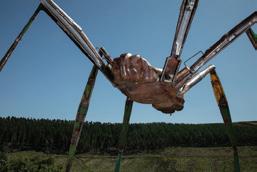
combine harvester dividers, gas guns, tanks and barbeque lid

3.3m high

18


Spider

bicycle forks and head light
70cm (h) x 180cm x 150cm
20
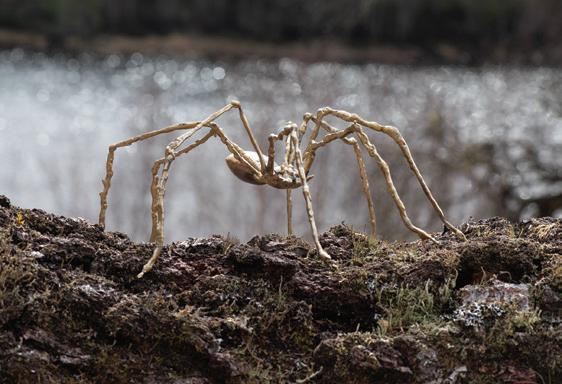
21
Golden Spider
spoons and brass
14cm (h) x 33cm x 33cm
Spoon Birds

Imp spoon, Pacific Steamboat spoon and Rolex spoon
8cm high x 15cm x 4cm

Snake
LARKS AND LAMBS
BELONG HALF TO THE SUN
I ONLY AM AN EARTH CREATURE
DIAMOND-STUDDED, HAMMERED FROM GOLD ORE, NOURISHED BY ROOTS.
 George Mackey Brown
George Mackey Brown
“I enjoy collaborating with other artists, especially poets”
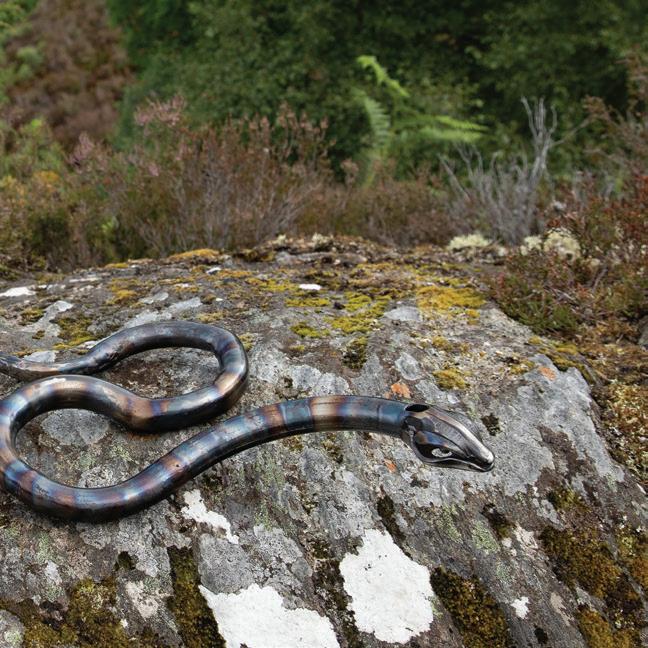

Oranutan mother and child
old British motorbike frames, brake shoes, scaffolding parts, pots and bells 66cm (h) x 114cm x 74cm

27

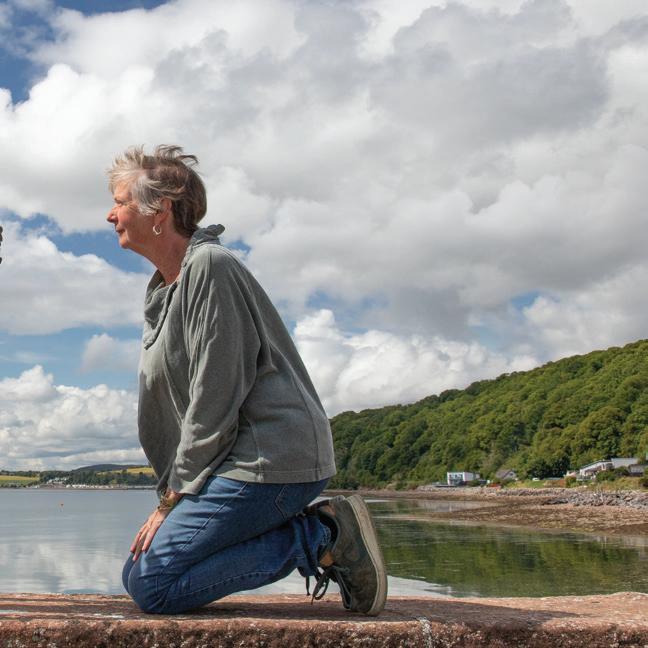
Orangutan male
old British motorbike frames, brake shoes, scaffolding parts and bolts
66cm (h) x 114cm x 74cm
30
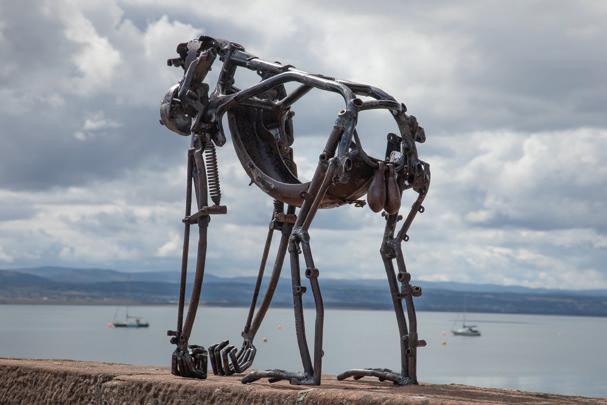
31
agricultural scrap, bicycle and scaffolding parts, hammers

32
Goat i
73cm (h) x 103cm x 32cm
agricultural scrap, bicycle and scaffolding parts, hammers

33
Goat ii
72cm (h) x 111cm x 38cm
Kite
agricultural parts, brake shoes and scythes

110cm (h) x 143cm x 69cm
 Red
Red


the beginning
During lockdown I found it difficult to be creative. I turned my attention to clearing broom, planting trees, appreciating the season, and paying attention to my environment and the wildlife I share it with.
That summer there was a particular song thrush who’s call I could identify over all the other birdsong and the ritual of listening and observing gave focus to my days. A bench was built, a poem written and a sculpture made. At the end of every day, I still sit on the song thrush bench with a dram while Corrie the lurcher contemplates the rabbits and the deer.
A conversation with a musician friend comparing quiet times led to a song being written and recorded. The title of the song is ‘Salvage,’ a perfect collaboration beginning with a bird.

‘Salvage’ has given me the opportunity to look back over the fifty years since beginning art school and my life as an artist ever since. It has been a real treat to have the time, space and opportunity to revisit old ideas and let the work take me wherever it wanted to go.
Thank you to everyone who has made this possible.
Helen Denerley, July 2023
SongThrush
brake shoes, scissors, nails and shelf-brackets 22cm (h) x 30cm x 9cm
36
Salvage Song
Jenny Sturgeon and Boo Hewerdine
She built a bench among the trees
Behind her house so she could hear
The song thrush in the April air
Salvage
And when it left as birds can do
She made from knives and old cog wheels
Reminder of the springtime there
Salvage
Fly fly fly
She takes the things we leave behind
And with a strength, the bluest flame
She gives our scrap another name
Salvage
Pennies and chameleons
She sees their form and understands
They’re reborn with knowing hands
Salvage
Turn a Norton Featherbed
Into the belly of a stag
Fenders become wings and rise
Salvage
Hammers, wrenches, planes and saws
Found in limbo at the yard
Welcome to another world
Salvage
Fly fly fly
To live again to know your mind
Perhaps that is the greatest gift
To ask not how but dream of it
Salvage
Fly fly fly
37
Helen’s Starlings
Helen has conjured starlings from brake shoes, Ball bearings for eyes, shelf brackets for tails, The legs old nails, new nails the toes, wings Plough mower blades, the feathers scissors, Knives, fork handles, ornithological scrap, A metallic murmuration on a fence.
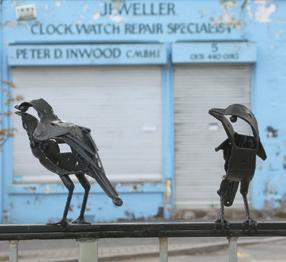 Michael Longley
Michael Longley
Salvage Bird
scoffold clips, brake shoes and scissors 19cm (h) x 28cm x 8cm
38
Starlings on a fence

Lizards

steel and brass
34cm
Three Bees
steel nuts and brass
3.5cm
40
(h) x 3.5cm x 4cm
x 18cm x 5cm

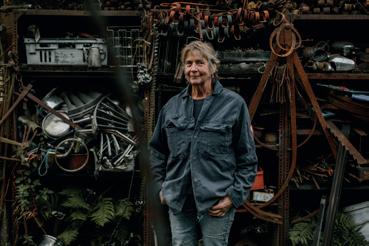
42
Denerley and her scrap pile, 2023
Helen Denerley is one of the UK’s leading wildlife artists, best known for the animals she sculpts from scrap metal. She has had many major exhibitions (four solo shows at Kilmorack) and has large works in public spaces throughout the UK, including a ‘tree of life’ for Trees for Life (Dungreggan 2023,) Edinburgh’s ‘Dreaming Spires’ Giraffes at the top of Leith Walk, and international commissions in Japan, Hong Kong and South Georgia.
For Denerley, the creative process begins with meticulously observed drawing and ends with a metal sculpture pulsing with life and movement. This is not rendered in solid form but realised in negative spaces, filled with the spirit of the animal and the viewer’s imagination.
Denerley graduated from Gray’s School of Art, Aberdeen in 1977. Since then she has lived and worked from her studio on a remote hillside in Northeast Scotland.

£8.00
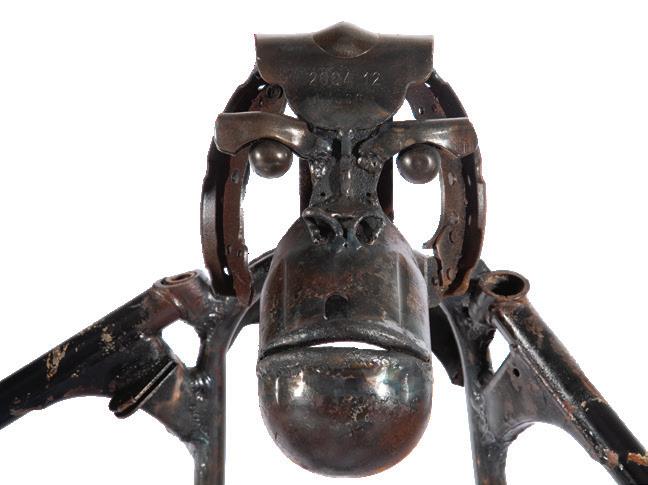


 Caliper Moth
Caliper Moth



























 George Mackey Brown
George Mackey Brown









 Red
Red



 Michael Longley
Michael Longley




